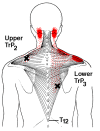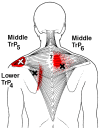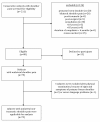High prevalence of shoulder girdle muscles with myofascial trigger points in patients with shoulder pain
- PMID: 21711512
- PMCID: PMC3146907
- DOI: 10.1186/1471-2474-12-139
High prevalence of shoulder girdle muscles with myofascial trigger points in patients with shoulder pain
Abstract
Background: Shoulder pain is reported to be highly prevalent and tends to be recurrent or persistent despite medical treatment. The pathophysiological mechanisms of shoulder pain are poorly understood. Furthermore, there is little evidence supporting the effectiveness of current treatment protocols. Although myofascial trigger points (MTrPs) are rarely mentioned in relation to shoulder pain, they may present an alternative underlying mechanism, which would provide new treatment targets through MTrP inactivation. While previous research has demonstrated that trained physiotherapists can reliably identify MTrPs in patients with shoulder pain, the percentage of patients who actually have MTrPs remains unclear. The aim of this observational study was to assess the prevalence of muscles with MTrPs and the association between MTrPs and the severity of pain and functioning in patients with chronic non-traumatic unilateral shoulder pain.
Methods: An observational study was conducted. Subjects were recruited from patients participating in a controlled trial studying the effectiveness of physical therapy on patients with unilateral non-traumatic shoulder pain. Sociodemographic and patient-reported symptom scores, including the Disabilities of the Arm, Shoulder, and Hand (DASH) Questionnaire, and Visual Analogue Scales for Pain were compared with other studies. To test for differences in age, gender distribution, and education level between the current study population and the populations from Dutch shoulder studies, the one sample T-test was used. One observer examined all subjects (n = 72) for the presence of MTrPs. Frequency distributions, means, medians, standard deviations, and 95% confidence intervals were calculated for descriptive purposes. The Spearman's rank-order correlation (ρ) was used to test for association between variables.
Results: MTrPs were identified in all subjects. The median number of muscles with MTrPs per subject was 6 (active MTrPs) and 4 (latent MTrPs). Active MTrPs were most prevalent in the infraspinatus (77%) and the upper trapezius muscles (58%), whereas latent MTrPs were most prevalent in the teres major (49%) and anterior deltoid muscles (38%). The number of muscles with active MTrPs was only moderately correlated with the DASH score.
Conclusion: The prevalence of muscles containing active and latent MTrPs in a sample of patients with chronic non-traumatic shoulder pain was high.
Figures








Similar articles
-
Topographical mapping and mechanical pain sensitivity of myofascial trigger points in the infraspinatus muscle.Eur J Pain. 2008 Oct;12(7):859-65. doi: 10.1016/j.ejpain.2007.12.005. Epub 2008 Jan 18. Eur J Pain. 2008. PMID: 18203637
-
Treatment of myofascial trigger points in common shoulder disorders by physical therapy: a randomized controlled trial [ISRCTN75722066].BMC Musculoskelet Disord. 2007 Nov 5;8:107. doi: 10.1186/1471-2474-8-107. BMC Musculoskelet Disord. 2007. PMID: 17983467 Free PMC article. Clinical Trial.
-
The prevalence of myofascial trigger points in neck and shoulder-related disorders: a systematic review of the literature.BMC Musculoskelet Disord. 2018 Jul 25;19(1):252. doi: 10.1186/s12891-018-2157-9. BMC Musculoskelet Disord. 2018. PMID: 30045708 Free PMC article.
-
Prevalence of Myofascial Trigger Points in Poststroke Patients With Painful Shoulders: A Cross-Sectional Study.PM R. 2019 Oct;11(10):1077-1082. doi: 10.1002/pmrj.12123. Epub 2019 Apr 16. PM R. 2019. PMID: 30734521
-
Myofascial origin of shoulder pain: a literature review.J Bodyw Mov Ther. 2015 Jan;19(1):91-101. doi: 10.1016/j.jbmt.2014.05.004. Epub 2014 May 15. J Bodyw Mov Ther. 2015. PMID: 25603748 Review.
Cited by
-
Management of chronic shoulder pain with restricted mobility - a case series.Indian J Anaesth. 2016 Nov;60(11):858-860. doi: 10.4103/0019-5049.193692. Indian J Anaesth. 2016. PMID: 27942063 Free PMC article. No abstract available.
-
Anatomical analysis of the motor endplate zones of the suprascapular nerve to the infraspinatus muscle and its clinical significance in managing pain disorder.J Anat. 2023 Sep;243(3):467-474. doi: 10.1111/joa.13868. Epub 2023 Mar 29. J Anat. 2023. PMID: 36988105 Free PMC article.
-
Shoulder Dysfunction in Parkinson's Disease: Implications of Motor Subtypes, Disease Severity, and Spinopelvic Alignment.J Mov Disord. 2025 Jul;18(3):213-221. doi: 10.14802/jmd.25032. Epub 2025 Apr 8. J Mov Disord. 2025. PMID: 40194788 Free PMC article.
-
DRY NEEDLING IN THE MANAGEMENT OF PATIENTS MEETING CLINICAL DIAGNOSTIC CRITERIA FOR SUBACROMIAL PAIN SYNDROME: A CASE SERIES.Int J Sports Phys Ther. 2019 Jul;14(4):637-654. Int J Sports Phys Ther. 2019. PMID: 31440414 Free PMC article.
-
Ultrasound-guided myofascial trigger point injection into brachialis muscle for rotator cuff disease patients with upper arm pain: a pilot study.Ann Rehabil Med. 2014 Oct;38(5):673-81. doi: 10.5535/arm.2014.38.5.673. Epub 2014 Oct 30. Ann Rehabil Med. 2014. PMID: 25379497 Free PMC article.
References
-
- Macfarlane GJ, Hunt IM, Silman AJ. Predictors of chronic shoulder pain: a population based prospective study. J Rheumatol. 1998;25(8):1612–1615. - PubMed
Publication types
MeSH terms
LinkOut - more resources
Full Text Sources
Medical

